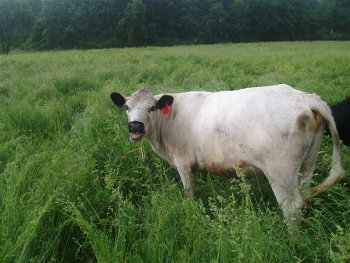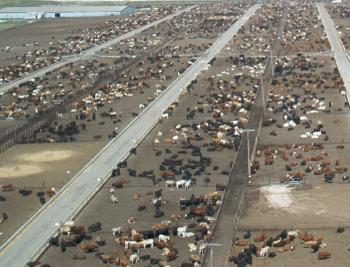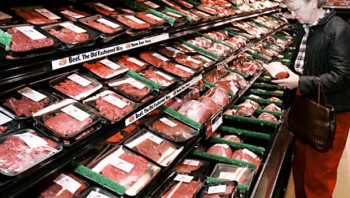AgriCulture bloggers Peter Davies and Mark Scherzer are the owners of Turkana Farms in Germantown, NY. This week Peter writes.

There is considerable discomfort around the nation’s feedlots as industrial cattle growers and their lobbyists find themselves with an increasingly tarnished image. And predictably it is blowbback time as the cattle industry (where almost all supermarket meat comes from) attempts to present itself as more environmentally friendly than pasture-based cattle raising systems (like ours at Turkana Farms for instance). The old grain fed vs. grass fed debate is back but this time with a difference — this time around it is being placed within the larger debate about greenhouse gases and their causes. (I am indebted to the Animal Welfare Approved Newsletter, winter 2012, vol. 5, issue 4 for its article “Grassfed and Greenhouse Gas" for my information. The article is derived from a longer report "A Breath of Fresh Air.") Methane gas, as we all know, is one of three major greenhouse gases believed to be contributing to climate change, and happens to be an inevitable by-product of cattle raising. The industrial cattle growers nowadays are arguing to all who will listen that it has been scientifically proven that their feedlot-raised cattle emit less methane per pound of meat than pasture raised cattle. And that the only way we can feed a growing global appetite for beef without reaching catastrophically high levels of methane production is to shift increasingly to the industrial feedlot system. Now it cannot be denied that grass-fed cattle, because they subsist on a fibrous diet, do emit more methane per pound than their corn/soy-eating brethren. The spokesmen for the industry seem, at first glance, to be telling you the truth. But they seem to be doing so only because they are deliberately, myopically focusing on just one aspect of the beef production process to the exclusion of everything else. As a rule of thumb, when you see a defense of the industrial mode of raising cattle that focuses only on the methane emitted by cattle you know there is, as Shakespeare would say, “something rotten in the state of Denmark."

The industrial cattle raisers need to be reminded that methane emanates not only from both ends of a cow but also from the cow’s manure once it has been deposited. In the pasture-raised system, the manure is distributed by the cows themselves throughout the fields in scattered cow plops (each of our cows daily drops 50 lbs of manure as it wanders about the pastures), and these cow plops degrade quickly, being exposed to the air, that is, in aerobic conditions. By contrast, in industrial farming the manure ends up in huge piles near the feedlots or in large poop lagoons, in what are described as anaerobic conditions — that is, conditions where no air is present. The significance of this is that the bacterial decomposition of manure, when no oxygen is present, produces much higher levels of methane than scattered cow plops on pasture. Just walk through our pastures on a lovely spring day and then by a manure pile or poop lagoon and smell the difference. Further, the manure of animals fed on a grain-based diet has a higher methane potential than manure from grass-fed animals. This is because their manure is more biodegradable. So the higher methane emissions from cow flatulence of grass fed beef is counterbalanced by the higher methane emission of manure from grainfed beef. Significantly, the blowback methane disinformation coming out of the industrial farming spokespeople fails to acknowledge any of this. They also fail to acknowledge that there are two other major greenhouse gases to be discussed in relation to cattle raising: nitrous oxide and carbon dioxide. One of the leading sources of nitrous oxide in farming is the use of nitrogen-based fertilizers. While such fertilizers are a standard part of grain production, pasture-raised operations like ours are more likely to rely solely on “homegrown" manure to build their soil fertility.

Missing from the industrial cattle growers argument is any mention of the millions of acres of corn and soy needed to feed the nation’s feedlot cattle. These acres have to be cultivated, planted, artificially fertilized, treated with herbicides, and pesticides, and harvested. And then finally shipped to the nation’s feedlots. All of these levels of production require petroleum, gasoline, diesel, and electricity. Research shows that the combined greenhouse gas emissions from every stage of industrial crop production to be between 226-426 kilograms of carbon dioxide equivalent per metric ton of corn. In other words, a pound of corn is responsible for emitting 0.23-0.43 lbs of carbon dioxide. On this basis, David Pimentel, a leading ecologist specializing in agriculture and energy at Cornell estimates a typical feedlot steer will in effect consume 284 gallons of oil in its lifetime. Our cows, getting their grass directly from the fields in the summer and hay from a nearby farm in winter, get by on a mere soupcan of oil. And this brings me to sequestration. No, not the sequestration that is so currently in the news — and that has such negative connotations. Rather carbon sequestration — a very positive thing, since carbon is one of the three greenhouse gasses we must reduce to slow or halt climate change. The relationship between pasture-raising cattle and carbon sequestration is still in the early stages of research, but there is already enough evidence to suggest that pasture-raising practices have a significant role to play in reducing carbon dioxide in the atmosphere.

Carbon sequestration is the natural process of transferring carbon dioxide from the atmosphere into the soil. How does it work? Cattle and other ruminants graze and naturally fertilize pasture, stimulating the grass to grow and produce more leaves and a denser mass of roots, where the carbon is ultimately stored. Current research suggests that the carbon can remain stored there for centuries. Researchers in the field are beginning to conclude that grass-fed livestock practices, by creating the right kind of dense grass, may have a vital role to play in helping to cut global gas emissions by creating an environment in which carbon is more efficiently sequestered. So when you see our British White cattle in the field, they are not only emitting methane, but they are also creating the ideal conditions for carbon sequestration. While we cannot ignore the fact that agriculture is a major contributor to global greenhouse emissions, we cannot do without it. We can, however, educate ourselves and assess what the best options are for choosing forms of agriculture that reduce greenhouse gases. Unfortunately, to do so we must constantly find our way through a tangle of disinformation. The primary form of disinformation regarding cattle raising at present is that methane production is the sole problem. If, dear reader, you think these kinds of discussions on cattle raising have little to do with you and how you live, just ponder some of the information above as you stroll down the meat aisles in your local supermarket, and think again.









